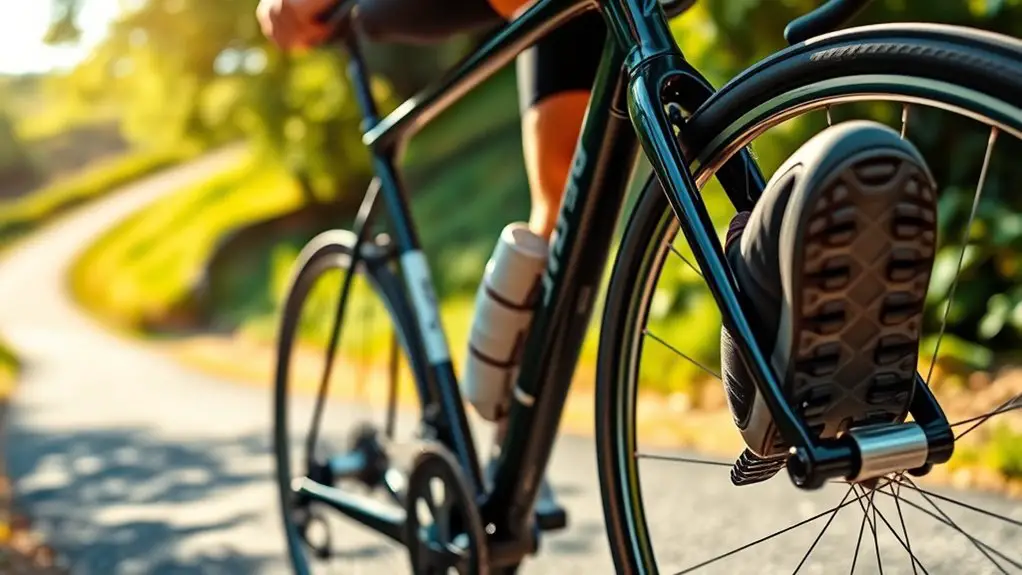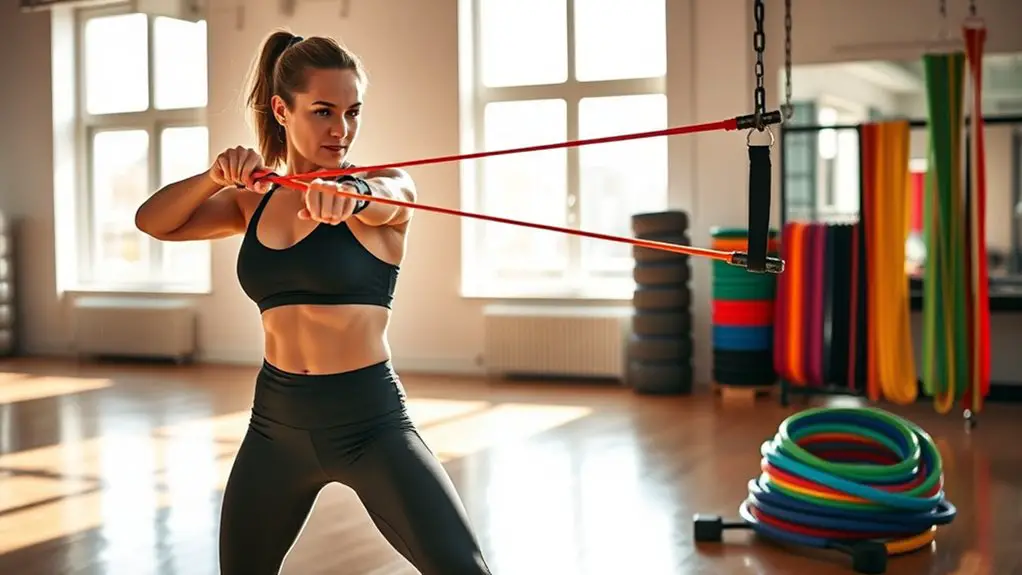To boost your sprinting performance, focus on key strength exercises like squats, deadlifts, and lunges for lower body strength. Incorporate box jumps for explosive power and agility, while pull-ups strengthen your upper body. Don't forget core exercises to enhance stability. Resistance band drills can help increase speed and power. By integrating these moves into your routine, you'll see improvements in acceleration and overall sprinting ability. Explore more effective exercises to level up your training!
Squats: Building Lower Body Strength
When it comes to enhancing your sprinting performance, incorporating squats into your routine is essential. Squats target your quads, hamstrings, and glutes, building the strength you need for powerful strides. By adding this fundamental exercise, you'll notice improved acceleration and speed, giving you the freedom to push your limits on the track.
You don't need fancy equipment; bodyweight squats or variations like goblet squats can easily fit into your training. Remember to focus on form to avoid injury and maximize gains. Aim for a mix of high reps for endurance and lower reps for strength. The more consistent you are, the more you'll feel that exhilarating sense of freedom as you release your full sprinting potential.
Deadlifts: Enhancing Explosive Power
Deadlifts are a game-changer for sprinters looking to enhance their explosive power. By incorporating deadlifts into your training routine, you'll not only build strength but also improve your overall sprinting performance. Here are three key benefits:
- Full-body engagement: Deadlifts activate multiple muscle groups, including your hamstrings, glutes, and core, essential for sprinting speed.
- Improved hip extension: This movement mimics the explosive hip drive needed during a sprint, helping you push off the ground more powerfully.
- Enhanced stability: Strengthening your posterior chain helps maintain balance and control, especially during high-speed runs.
Lunges: Developing Balance and Stability
Incorporating lunges into your training can greatly enhance your balance and stability, both of which are essential for sprinters. This exercise challenges your core and leg muscles, forcing you to maintain control during explosive movements. By performing forward, reverse, and lateral lunges, you'll engage different muscle groups, improving your overall strength.
As you lunge, focus on your form—keeping your knee aligned with your ankle and your chest up. This not only builds muscle but also enhances your proprioception, making you more aware of your body in space.
Adding lunges to your routine helps you feel grounded and agile, allowing you to sprint with confidence. So, get ready to embrace the freedom of movement lunges can offer!
Box Jumps: Improving Plyometric Ability
Box jumps are a powerful tool for sprinters looking to enhance their plyometric ability. By incorporating this explosive exercise into your routine, you'll develop strength, speed, and agility, all essential for sprinting performance. Here are three key benefits of box jumps:
- Increased Power: Box jumps recruit fast-twitch muscle fibers, boosting your explosive strength.
- Improved Coordination: This exercise helps refine your body control and timing, vital for sprinting efficiency.
- Enhanced Flexibility: Jumping onto a box stretches and strengthens your lower body, improving overall athleticism.
Make box jumps a staple in your training plan, and you'll feel the difference in your sprinting prowess. Embrace the freedom of movement they offer, and watch your performance soar!
Leg Press: Targeting Quad and Hamstring Strength
After mastering box jumps, it's time to focus on another fundamental exercise: the leg press. This machine lets you target your quads and hamstrings effectively, helping you build the strength necessary for explosive sprinting. When you sit down and position your feet, remember to keep your back flat against the pad. Press through your heels, extending your legs while controlling the weight. You'll feel your muscles engaging, which translates directly to faster sprinting speeds. Aim for a rep range that challenges you but allows for good form. As you get stronger, consider varying your foot placement to hit different muscle fibers. The leg press isn't just about lifting weight; it's about releasing your sprinting potential. Get ready to feel the difference!
Power Cleans: Boosting Full-Body Strength
Power cleans are a game-changer for sprinters looking to boost their full-body strength. This explosive lift not only enhances your power but also improves coordination and speed, vital for sprinting success. To maximize the benefits, focus on these key elements:
- Technique: Mastering the form guarantees you're engaging the right muscles and minimizing injury risk.
- Speed: Performing the lift explosively helps develop the fast-twitch muscle fibers essential for sprinting.
- Core Engagement: A strong core stabilizes your body during the lift, translating to better sprinting posture.
Incorporating power cleans into your training regimen can elevate your performance and give you the freedom to release your full potential on the track. Embrace the challenge and feel the difference!
Hip Thrusts: Maximizing Glute Activation
While many exercises focus on building leg strength, hip thrusts specifically target glute activation, which is essential for sprinters. Strong glutes enhance your speed and power, enabling you to push off the ground more effectively. Here's a quick overview of the benefits of hip thrusts:
| Benefit | Description | Impact on Sprinting |
|---|---|---|
| Increased Power | Boosts explosive hip extension | Improves sprint speed |
| Enhanced Stability | Strengthens pelvis and lower back | Reduces injury risk |
| Greater Muscle Gain | Targets glute muscles specifically | Increases overall strength |
| Improved Posture | Encourages better alignment | Supports efficient running form |
| Versatile Exercise | Can be modified for different levels | Adapts to your training needs |
Incorporate hip thrusts into your routine, and feel the difference!
Pull-Ups: Strengthening the Upper Body
Although many sprinters focus on lower body strength, upper body strength is equally essential for peak performance. Pull-ups are a fantastic way to build that upper body strength, enhancing your sprinting capability. Here's why you should incorporate them into your routine:
- Improved Arm Drive: Stronger arms contribute to better arm movement, which helps maintain speed and rhythm during sprints.
- Enhanced Stability: A strong upper body provides stability, allowing your lower body to work more efficiently.
- Injury Prevention: Strengthening your back and shoulders can reduce the risk of injuries, keeping you free to train hard.
Incorporate pull-ups into your workouts, and you'll see a noticeable boost in your sprinting performance and overall athletic prowess.
Core Exercises: Stabilizing the Body for Sprinting
Building upper body strength with exercises like pull-ups sets a solid foundation, but don't overlook the importance of core stability for sprinters. A strong core not only enhances your speed but also promotes freedom of movement. Exercises like planks, Russian twists, and medicine ball throws can transform your sprinting performance.
| Emotion | Core Exercise |
|---|---|
| Empowerment | Plank |
| Balance | Russian Twist |
| Control | Medicine Ball Throw |
| Freedom | Bicycle Crunch |
| Strength | Dead Bug |
Incorporating these core exercises into your routine will stabilize your body, allowing for a more powerful sprint. With a solid core, you'll feel more in control, ultimately releasing your potential on the track.
Resistance Band Drills: Increasing Speed and Agility
Incorporating resistance band drills into your training can greatly enhance your speed and agility on the track. These drills not only build strength but also improve your explosiveness. Here are three effective resistance band drills you should try:
- Lateral Band Walks: Strengthen your hip abductors to improve lateral movement, keeping you agile during sprints.
- Resisted Sprints: Attach a band to your waist and sprint forward. This creates resistance, forcing your muscles to work harder and develop power.
- High Knee Runs with Bands: Anchor a band to a sturdy object and perform high knees. This drill improves your running form while engaging your core and legs.
Add these drills to your routine, and watch your speed and agility soar. Embrace the freedom they bring to your training!
Frequently Asked Questions
How Often Should Sprinters Incorporate Strength Training Into Their Routine?
You should incorporate strength training into your routine about two to three times a week. It'll enhance your performance, boost your speed, and reduce injury risk, giving you the freedom to excel in your sprinting endeavors.
What Role Does Nutrition Play in Strength Training for Sprinters?
Imagine your body as a finely tuned machine; without the right fuel, it sputters. Nutrition's your ally in strength training, ensuring energy's abundant, recovery's swift, and performance soars. Embrace it, and watch your limits dissolve.
Should Sprinters Focus on High Reps or Heavy Weights?
When deciding between high reps or heavy weights, you should consider your goals. Heavy weights build strength, while high reps enhance endurance. It's about balancing both for ideal performance and personal freedom in your training.
How Can Strength Training Reduce the Risk of Injuries for Sprinters?
Think of strength training as your body's armor. It builds resilience, stabilizes joints, and enhances muscle control, reducing injury risks. When you're strong, you can sprint freely, releasing your full potential with confidence and power.
What Is the Best Time to Do Strength Training in Relation to Sprinting Workouts?
You should schedule strength training after sprint workouts or on separate days. This way, you'll maximize your energy for sprints while allowing muscles to recover, ultimately enhancing both performance and strength without compromising your freedom to train effectively.




